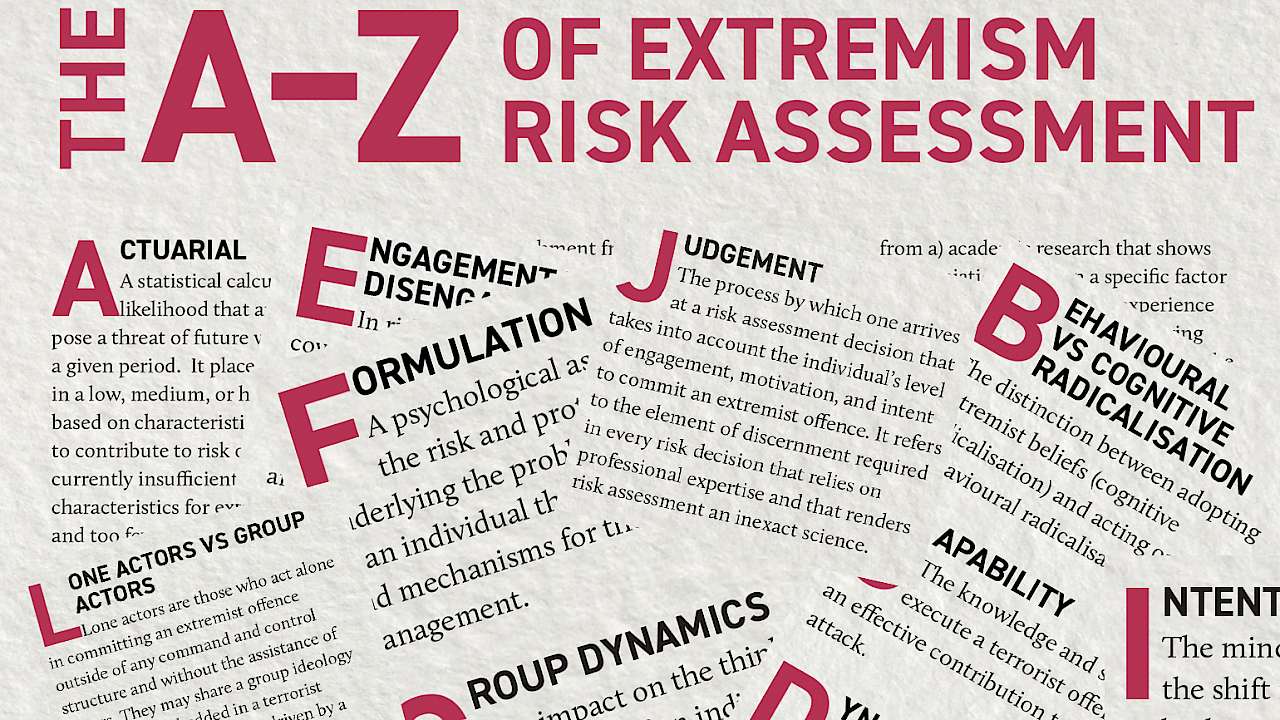Actuarial
A statistical calculation of the likelihood that an individual will pose a threat of future violence within a given period. It places an individual in a low, medium, or high-risk category based on characteristics that are known to contribute to risk of harm. There are currently insufficient known terrorist characteristics for extremist offenders and too few numbers to support such an approach to risk assessment for extremist violence.
Behavioural vs cognitive radicalisation
The distinction between adopting extremist beliefs (cognitive radicalisation) and acting on them (behavioural radicalisation).
Capability
The knowledge and skillset to execute a terrorist offence or make an effective contribution to a terrorist attack.
Dynamic vs static factors
The distinction between those factors that are subject to change, such as attitudes or beliefs (dynamic factors) and those that are fixed, such as criminal history or childhood experiences (static factors).
Engagement vs disengagement
In risk assessment, ‘engagement’ covers emotional, ideological, and practical participation and involvement with extremist ideas and groups, in contrast to the loss or abandonment of an extremist ideology or the withdrawal or detachment from a group.
Formulation
A psychological assembling of the risk and protective factors underlying the problematic presentation of an individual that informs the targets and mechanisms for their change or management.
Group dynamics
The impact on the thinking and behaviour of an individual within a group with whom they are closely identified, and that can contribute to both their cognitive and behavioural radicalisation.
Harm prevention
The goal of risk or threat assessment that requires precise knowledge about the risk of harm to whom and in what circumstances, to inform risk management.
Intent
The mindset that corresponds with the shift from cognitive to behavioural radicalisation and the decision to carry out or contribute to a terrorist offence.
Judgement
The process by which one arrives at a risk assessment decision that takes into account the individual’s level of engagement, motivation, and intent to commit an extremist offence. It refers to the element of discernment required in every risk decision that relies on professional expertise and that renders risk assessment an inexact science.
Knowledge
The acquired knowledge of relevant risk factors for terrorism from a) academic research that shows an association between a specific factor and a terrorism risk, b) the experience gained from assessing and managing terrorism cases, and c) knowledge of the psychology of human behaviour and the needs met by extremist engagement and terrorist violence.
Lone actors vs group actors
Lone actors are those who act alone in committing an extremist offence outside of any command and control structure and without the assistance of others. They may share a group ideology but are not embedded in a terrorist group, and are more often driven by a personal issue not shared by others.
Multifinality and equifinality
These are terms used in terrorist risk assessment that refer to the processes by which individuals can arrive at the same destination by many different routes (equifinality) and by which those with similar starting points can end up at different destinations (multifinality).
Narcissism
Narcissism was considered for some time to be a master explanation for terrorism. Extremist ideologies promise supremacy and there is some evidence that those with exaggerated self-importance are attracted to them for this reason. It is now viewed more proportionately as one of the personality features associated with terrorist group leaders and some lone actors who fail – perhaps because of their self-centeredness, to embed in a group.
Outcome studies
Outcome studies in terrorism research seek to evaluate and optimise the outcomes of risk assessment and its management, as well as interventions with terrorist offenders, with the long-term goal of identifying what works.
Protective factors vs risk factors
Protective factors are the antidote to risk factors and are an essential element in the assessment and management of the threat of extremism. They decrease the chances of risk factors emerging and mitigate them where they do. The risk factors for terrorism apply to many others who hold similar grievances and have failed to find their place in society but who have not become extremists. It can be the factors that are key to understanding how they have been protected from this pathway.
Quality assurance and quality control
For frameworks that structure and guide extremist risk assessment, quality assurance is achieved through studies that measure their reliability (the consistency of their performance when used by different assessors) and their validity (from outcome studies that confirm that the frameworks are actually measuring what they purport to measure). Quality control is achieved by ensuring that those who use these frameworks are suitably trained and experienced in their use.
Reliability
Reliability refers to the dependability of risk assessment frameworks. It is evaluated by studies that check the inter-rater reliability of those using the framework independently but in the same setting and with the same type of people. Reliability is expressed in Kappa values from 0.4 to 1.0, with values 0.6 and above corresponding with moderate to perfect agreement.
Structured Professional Judgement (SPJ)
SPJ is an approach to risk assessment that structures professional judgement by means of evidence-based guidelines. These provide a set of operationally defined and evidence-based risk factors, coding procedures for assessing their relevance to the individual case, and guidance for how to integrate these to reach a final decision about risk.
Threat assessment
Threat assessment takes place before an offence has been committed and is concerned to detect it and prevent it occurring. It is carried out by police and intelligence analysts. This is distinct from risk assessments that take place after an offence has been committed and are concerned to assess the potential of an already convicted offender reoffending in the future. It is carried out by correctional professionals in prisons or other secure settings.
Utility
Utility captures the value of a risk-assessment framework to its stakeholders. It corresponds to the extent to which they believe that the risk decisions it informs are superior to those that are made without it. It is a necessary but insufficient measure of the worth of a risk assessment tool.
Validity
Validity is the gold standard for a risk assessment tool. It provides stakeholders with the confidence that it measures what it purports to measure and that its findings are meaningful. Ongoing outcome studies provide a continuing source of feedback to maintain confidence in its validity.
What works
This refers to the evidence base that accrues from systematically evaluating the outcome of correctional practice in the assessment and management of risk. The utility of a risk assessment framework cannot be assumed but needs to be evidenced.
X
A ‘classic’ formula used to describe generic risks from natural and man-made hazards is: Risk = Threat x Vulnerability x Consequence. Historically, such formulae were used to set priorities for protecting infrastructures against natural hazards such as flooding and hurricanes. However, the ‘x’ is controversial when considering terrorism risk. For terrorism risk to infrastructures, such formulae may be inadequate because threats, vulnerabilities, and consequences may not be independent with feedback loops existing between these factors due to the actions of intelligent adversaries.
Youth
Increasingly the caseload of Channel/Pursue referrals includes teenagers. Risk assessment and management strategies may need to be tailored for adolescent populations because their risk/protective factors and intervention needs may differ from adults.
Zero risk
All activity carries some risk. The only way to ensure zero risk is to allow no activity at all. Assessments gauge whether the level of risk is acceptable and manageable in the political and social context in which it may manifest.
Copyright Information
As part of CREST’s commitment to open access research, this text is available under a Creative Commons BY-NC-SA 4.0 licence. Please refer to our Copyright page for full details.
IMAGE CREDITS: Copyright ©2024 R. Stevens / CREST (CC BY-SA 4.0)







